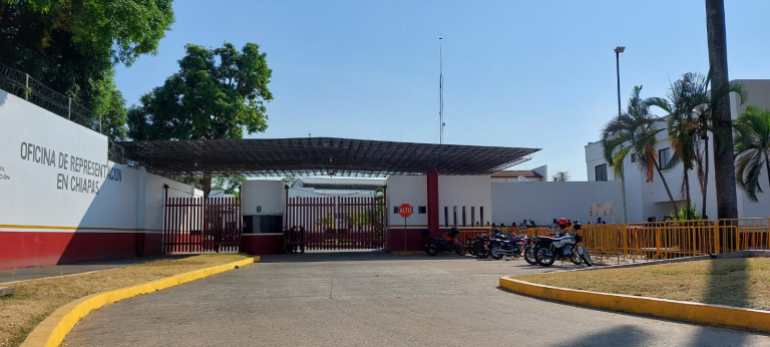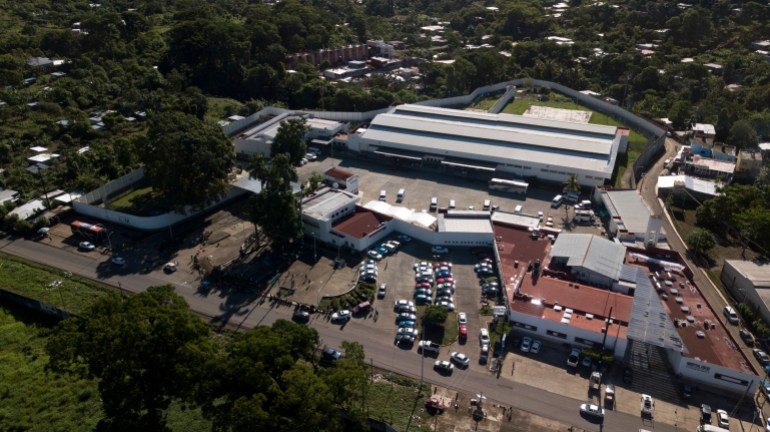‘I was a prisoner of Mexico’s US-backed migrant detention regime’
An American writes about her time in the migrant prison city of Tapachula, where she is threatened with deportation from the other side of the fence.

On July 11, 2021, I arrived by car at Tapachula International Airport in the Mexican state of Chiapas – a grandiose title for the diminutive compound and runway plunked down amidst tropical vegetation just west of Mexico’s border with Guatemala – for what was meant to be my return flight to the neighbouring state of Oaxaca, where I had taken up accidental residence at the start of the pandemic the previous year.
I had come to Tapachula for four days with a vague plan to write something about migrants, of which there were plenty. During my initial excursion to the city centre, the woman who served me juice at a market stall reported that, out of every 10 people nowadays, five were Haitian, three were Cuban or something else, and two were chiapanecos (natives of Chiapas). Gesturing at the ground beyond the stall, she remarked: “Sometimes at night it seems like a hotel around here with people sleeping all over.” After attending to the licuado orders of the pair of Cuban men seated next to me in Brazil soccer tank tops and flip-flops, the woman proceeded to entertain me with stories of coronavirus dishwashing protocols and their effects on her now bleach-burned hands.
Keep reading
list of 3 itemsThe Darién Gap: A deadly extension of the US border
Letter from a mass grave in Mexico
Plagued by an almost neurotic aversion to behaving like a journalist, I had spent the morning wandering awkwardly around and inventing pretexts to talk to people, like the young Haitian man on a bench who could not tell me how to get to the market but who patiently put up with me as I swung the conversation in other directions. He had arrived at Tapachula a month earlier from Brazil, a distance of several thousand kilometres, much of which he had travelled on foot. Obviously, he said, he would have preferred to be at home in Haiti; doesn’t everyone want to be in their own home? He gazed at a point over my shoulder and shrugged with a resigned smile – a shrug that better encapsulated the arbitrary cruelty of a world defined by borders than anything I could ever write.
Another of my interlocutors was a young Nicaraguan with “Juan 3:16” tattooed on the side of his neck – a reference, Google later informed me, to the Bible verse according to which “God so loved the world that he gave his one and only Son, that whoever believes in him shall not perish but have eternal life”. This young man had worked in radio in Nicaragua, and, putting on a deep voice, performed a rapid-fire dedication “to Belén in Tapachula” as he accompanied me in search of the Coppel department store that I urgently needed to find.
Our stroll was briefly interrupted when Juan 3:16 had to chase down the Mexican youth who had relieved a distraught schoolgirl of her mobile phone. Upon his return, he recounted to me the highlights of hitchhiking through Honduras and Guatemala to Mexico, where he was promptly apprehended on a minibus by Mexican immigration officers.
He would have liked to have made it somewhere cold, like Michigan, he said, but instead he ended up imprisoned for 23 days in Tapachula’s notoriously overcrowded and abuse-ridden estación migratoria – “migration station” – which had thanks to the either witting or unwitting irony of a previous Mexican government been christened Siglo XXI, meaning “21st century”. Inside, he had apparently contracted COVID – or at least that is what he had deduced from his inability to breathe for various days – but reckoned that the psychological torment had been just as bad or worse. He had since applied for asylum in Mexico and was now sleeping indefinitely on the streets of Tapachula awaiting his next appointment with COMAR, the Mexican Commission for Refugee Assistance, while also endeavouring to recuperate his confiscated video camera from the dark void into which it had been disappeared by immigration personnel.

I had heard, of course, of Siglo XXI, a facility listed on the website of the Geneva-based Global Detention Project as having these “inadequate conditions”: temperature, access to clean drinking water, showers and toilets, access to internet, access to telephones, bedding and clothing, cell space, food provision, hygiene, medical care, overcrowding, solitary confinement and protection from physical injury. In the “outcomes” section of the listing, the boxes corresponding to “reports of deaths” and “reports of suicide attempts” are both marked “yes”.
As The Associated Press reported back in 2019, Siglo XXI – said to be Latin America’s largest immigration detention centre – is a “secretive place off-limits to public scrutiny where cellphones are confiscated and journalists aren’t allowed inside”. The AP had itself been denied access but had heard testimony according to which “women slept in hallways or in the dining hall among rats, cockroaches and pigeon droppings as children wailed, mothers reused diapers and guards treated everyone with contempt”.
When I brought up Siglo XXI to the friends I was staying with in Tapachula – we’ll call them Diego and Polo, both employees of an immigrant rights organisation – Polo offered to drive me past the facility, located on the northern outskirts of the city towards the Tacaná volcano. Assuming that this would be the closest I’d ever get to 21st century barbarity, I peered through the car window at the looming complex – an appropriately symbolic landmark in a city Polo had dubbed “Atrapachula” based on its service, in his own unminced words, as an “imperial f****** holding pen” and trap for United States-bound migrants, with the US bullying Mexico into performing its dirty work against people often fleeing US-fuelled catastrophe in the first place.
I jotted down some notes about Siglo XXI as a migrant prison within the migrant prison of Tapachula and figured I had enough material for at least an article or two cataloging the latest migrant-related transgressions of my heinous homeland to the north. On the morning of my scheduled return to Oaxaca, I paid a guilty visit to that imperial outpost known as Walmart, where I acquired bread and a giant slab of industrial Manchego cheese for my trip as well as two bottles of wine, which I assumed Diego and Polo would assist in consuming prior to my departure. When they proved less than helpful on that front, occupied as they were with preventing the cat from devouring an injured bird in the backyard, most of the work fell to me – meaning that I was in spectacular shape by the time they dropped me off at the airport, and at first thought nothing of it when a female immigration officer requested my forma migratoria múltiple, or Mexican entry permit, something that had never before happened on a domestic flight.
I busied myself scrolling through Facebook on my phone while other passengers streamed past me to the security check and the immigration officer – we’ll call her Migra 1 – alternately inspected my passport, my forma migratoria and her computer. Through my wine-altered state, I eventually perceived that an extraordinary amount of time had elapsed and made eye contact with Migra 1, who with raised eyebrows advised me that neither my forma nor the June 2021 entry stamp in my passport were “in the system”. In fact, she said, my last appearance in the system was March 2020 – which was indeed the last time I had actually entered Mexico rather than lazily relying on some dude in Mexico City to provide me with a falsified forma migratoria and entry stamp after my initial visa had expired. In an effort to save my a**, I mustered my best self-righteous gringa demeanour, rolled my eyes in exaggerated fashion and requested that the “system” sort itself out as quickly as possible as I had places to be. I then retired a few metres and frantically phoned the Mexico City dude, who did not answer, and Diego, who did – and who said something to the effect of: “Oh, s***.”
The next thing I knew, I was being ordered to turn off my phone as Migra 1 and Migra 2, a man, escorted me to a small back room with a desk and Xerox machine. From that point on, my recollection of events is a blur, but I have been able to piece them together thanks to several pages of notes scribbled in real time. Granted, my decision to whip out a pen was perhaps a result not so much of foresight as of a need to project importance – and, in case Migras 1 and 2 had not adequately received the message, I announced that I was a journalist and would be writing about this whole episode. According to my notes, I also announced that I would just walk out of the airport and be done with it all but was told that such behaviour would occasion the summoning of the National Guard.

After reflecting for a couple of lines on the novelty of not having my way, I apparently switched gears and got a little bit excited about the inside view I had finagled of the migrant detention apparatus. Some notes ensued on the serendipity of my misfortune, interspersed with expressions of culpability re: the grotesque privilege obviously enjoyed by anyone who is able to experience excitement at being detained. I could not have asked for a better scoop on Atrapachula, I gushed to my notebook, than being atrapada (trapped) myself (or would it be atrapachulada?). I tried interrogating my interrogators, but this produced little information aside from that Migra 1 had worked in immigration for four years and liked it, that cross-border migration from Guatemala had indeed been on the rise and that some “illegal” migrants had attempted – like me – to fly out of Tapachula airport. When I asked if the migrant-trapping orders originated in the US, Migra 2 nodded but then revised his response to the noncommittal: “We do not have that information.” Nor was he cooperative when I sought to establish whether the “GOOOOOOOOLLLLL” that emanated from a television set somewhere in the airport corresponded to Italy or England and simply stared at the wall.
At some point, it occurred to me that I might be deported to the US – with this precise moment recorded in my notebook as: “f*** are they going to deport me can you imagine haha.” In addition to not having lived in the US since graduating college in 2003, I hadn’t set foot in the country in six years – not even transiting through its airports – as I found it to be irreparably creepy and hazardous to my mental health. The US is itself mentally ill, and there is perhaps no better indication of this than that it is the only place in the world where students are regularly massacred at school – a phenomenon that has to do with more than just the ludicrous ease with which armaments can be procured. When I was growing up in Austin, Texas, I thought it was entirely normal for eight-year-old me to be shooting beer cans off fence posts with my parents’ friend’s pistol. I also became well acquainted with the soulless consumerism that passes for culture in the US and the idea that life is a competition as opposed to a communal collaboration – a brutal dog-eat-dog arrangement that fuels individual alienation and is clearly not helped by the government’s penchant for spending trillions of dollars on wars abroad rather than on, say, physical and mental healthcare for the domestic population. But a sick society is ultimately more profitable for the arms and pharmaceutical industries that underpin US capitalism, and business proceeds as usual.
Resuming my state of panic in the back room of the Tapachula airport, I had begun sketching notes about how to sneak back into Mexico by land from Texas when Migra 1 declared that my ride had come. Motioning for me to gather my bags, she escorted me out of the airport to a waiting van, saying only that I would be taken to a centro migratorio where my “situation” would be “resolved”.
I climbed into the van, the back row of which was occupied by a young Honduran woman from San Pedro Sula, whose small son was sleeping in her lap. They had been travelling for five days straight, she told me, and had been detained on a bus outside Tapachula by immigration officials. The only hope now, she said, was to apply for asylum in Mexico as the excessive crime rate in Honduras ruled out the possibility of return. Giggling politely at my suggestion that even the Honduran president – US narco-buddy Juan Orlando Hernández – was a criminal, she shifted her son on her lap as I took a seat in the front row of the van and peered through the grated partition at Migra 3, the driver, and the member of the National Guard who was occupying the passenger’s seat.
Glancing back over his shoulder, the Guardia Nacional asked where I was from – and then swung fully around to stare at me in shock after hearing the answer, which didn’t do much to assuage my feelings of self-hatred at the superior value my passport automatically conferred upon my life.
“What are you doing here?” he inquired amusedly and went on to express his opinion that I would certainly be deported – but that, not to worry, it would be free of charge! First, however, my situation had to be resolved. I don’t recall the exact moment at which I realised where I was being taken, but it must have been shortly after Migra 3 put the van in motion. At any rate, the epiphany is forever preserved in my notebook as: “F***. SIGLO XXI.”

This excerpt is the first chapter of “Inside Siglo XXI: Locked Up in Mexico’s Largest Immigration Detention Center”, a book by Al Jazeera opinion columnist Belén Fernández about her 24-hour jail stint in 2021 and exclusive view of the US-dictated migrant detention apparatus on Mexico’s southern border. While incarcerated, she was able to speak with refuge seekers from all over the world whose humanity defied a deeply dehumanising system. The book is published by OR Books and is available from the OR website, Amazon and numerous other sellers.